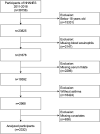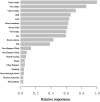Association between serum folate levels and blood eosinophil counts in American adults with asthma: Results from NHANES 2011-2018
- PMID: 36911740
- PMCID: PMC9993087
- DOI: 10.3389/fimmu.2023.1134621
Association between serum folate levels and blood eosinophil counts in American adults with asthma: Results from NHANES 2011-2018
Abstract
Background: To date, many researches have investigated the correlation of folate and asthma occurrence. Nevertheless, few studies have discussed whether folate status is correlated with dis-ease severity, control or progression of asthma. So, we explored the correlation of serum folate and blood eosinophil counts in asthmatic adults to gain the role of folate in the control, progression, and treatment of asthma.
Methods: Data were obtained from the 2011-2018 NHANES, in which serum folate, blood eosinophils, and other covariates were measured among 2332 asthmatic adults. The regression model, XGBoost algorithm model, and generalized linear model were used to explore the potential correlation. Moreover, we conducted stratified analyses to determine certain populations.
Results: Among three models, the multivariate regression analysis demonstrated serum folate levels were negatively correlated with blood eosinophil counts among asthmatic adults with statistical significance. And we observed that blood eosinophil counts decreased by 0.20 (-0.34, -0.06)/uL for each additional unit of serum folate (nmol/L) after adjusting for confounders. Moreover, we used the XGBoost Algorithm model to identify the relative significance of chosen variables correlated with blood eosinophil counts and observed the linear relationship between serum folate levels and blood eosinophil counts by constructing the generalized linear model.
Conclusions: Our study indicated that serum folate levels were inversely associated with blood eosinophil counts in asthmatic adult populations of America, which indicated serum folate might be correlated with the immune status of asthmatic adults in some way. We suggested that serum folate might affect the control, development, and treatment of asthma. Finally, we hope more people will recognize the role of folate in asthma.
Keywords: asthma; eosinophil; folate; machine learning; national health and nutrition examination survey.
Copyright © 2023 Wen, Wang, Giri and Guo.
Conflict of interest statement
The authors declare that the research was conducted in the absence of any commercial or financial relationships that could be construed as a potential conflict of interest.
Figures



References
-
- Soriano JB, Abajobir AA, Abate KH, Abera SF, Agrawal A, Ahmed MB, et al. . Global, regional, and national deaths, prevalence, disability-adjusted life years, and years lived with disability for chronic obstructive pulmonary disease and asthma, 1990-2015: A systematic analysis for the global burden of disease study 2015. Lancet Respir Med (2017) 5(9):691–706. doi: 10.1016/S2213-2600(17)30293-X - DOI - PMC - PubMed
-
- Wang H, Naghavi M, Allen C, Barber RM, Bhutta ZA, Carter A, et al. . Global, regional, and national life expectancy, all-cause mortality, and cause-specific mortality for 249 causes of death, 1980-2015: A systematic analysis for the global burden of disease study 2015. Lancet (London England). (2016) 388(10053):1459–544. doi: 10.1016/S0140-6736(16)31012-1 - DOI - PMC - PubMed

